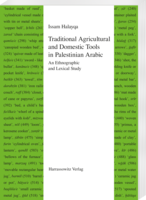|
|
more titles of the subject:
Download:
Please note: With adding digital Products to your cart
the payment will be handled via PayPal. The download will be provided after the payment is confirmed. Issam Halayqa describes the ethnographic and lexical backgrounds of the names of the agricultural and domestic tools and objects used by the inhabitants of rural communities, villages, and cities of Palestine until the end of the British Mandate. As an attempt to document them, 618 names of tools were gathered through field and research work. The study first defines the form of the tools, the materials they were made of, and their use in the agricultural contexts, and then traces their lexical origin and their counterparts in ancient Near Eastern languages.
Two results were achieved within this research; both are displayed on tables annexed to the work. Firstly, the natural and cultural factors that stimulated inhabitants to create the terminology of the tools and objects are displayed. Secondly, the linguistic strata the names of tools and objects represent is analyzed. The outcome is that there was a considerable percentage of loaned words from ancient Semitic languages like Aramaic, Canaanite, and Akkadian, and that other words were loaned from non-Semitic languages like Greek, Latin, Persian, and Turkish. The study shows the interference of the languages of the area with historically mixed communities reflected in the tool names, as well a case of multilingualism in that many Semitic and non-Semitic languages had been used in small geographical loci. |
|||||||||||||||||||||||||||||||||||||||||






